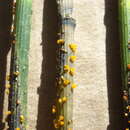en
names in breadcrumbs


This is a short conclusion of my noneditioned results concerning the genus, thus kept as short as useful for pupose.
Stamnaria Fuckel is a fungal genus of Ascomycetes, for usual regarded to belong to Helotiales or Leotiales. All true! Stamnaria spp. were hitherto solely found growing on living or decaying Equisetum spp., Horsetails.
There are published S. spp. growing on different substrates, still these in fact are clearly not congeneric. S. persoonii is type species, syn. S. equiseti (proved curator) got prior basionym but is less known, does grow its sexual state (teleomorph) on last years remainings of Equisetum fluviatile, sometimes E. arvense. S. americana grows on living shoots of E. hyemale solely, during cold season.
These two spp. are all published combinations for the genus which in fact belong here!
I described 4 additional species plus one subsp. to the genus in my master-thesis and there seem to be further ones, unfortunately these are still waiting for publication, but this has shown the strictly Equisetum-inhabiting genus being highly substrate-specific within host genus and comprising several more spp.
Ascocarps, generative Fruitbodies are disciform ("Discomycetes") to urceolate in shape, S. persoonii shows a conspicous collar built from outer hyaline excipulum. They are bright orange-yellow to orange when hydrated, darker when exsicc., containing coloured globules in some parts. Vegetative spores, conidia, resp. building structures may regularly be found on living or deceasing horsetails and are collectively termed Titaeospora equiseti.
Stamnaria is a genus of fungi in the family Helotiaceae.[1] The genus contains at least 7 species, all of which are parasites of horsetails, reproducing through apothecia which burst through the outer surface of the hosts. It has an anamorph (asexual stage) with genus name Titaeospora, but according to current rules the holomorph name Stamnaria should be used where possible.[2][3]
As acceped by Species Fungorum;[4]
Stamnaria is a genus of fungi in the family Helotiaceae. The genus contains at least 7 species, all of which are parasites of horsetails, reproducing through apothecia which burst through the outer surface of the hosts. It has an anamorph (asexual stage) with genus name Titaeospora, but according to current rules the holomorph name Stamnaria should be used where possible.